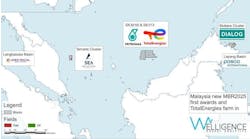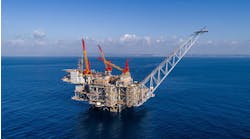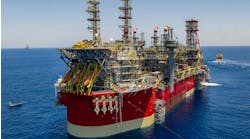Tim Shea
ARC Advisory Group
ARC Advisory Group research indicates that use of leak detection systems (LDS) in upstream production and gathering operations and midstream pipelines continues to expand. In fact, subsea appears to be one of the fastest-growing segments for the technology.
An increasing number of owner-operators now view leak detection systems as a positive investment in safety as well as a requirement for regulatory compliance. LDS can often provide a form of insurance against undetected leaks that could negatively impact a company's bottom line and reputation.
The global upstream oil and gas industry has been growing and evolving in a rapid and dramatic way. The global midstream market is also growing, albeit not as rapidly, as companies will require pipeline and other infrastructure and networks to transport natural gas, natural gas liquids (NGL), and oil from the wellhead to the refinery; from the refinery to storage and distribution terminals; and ultimately, to the industrial, commercial, or retail consumer.
There have been an increasing number of high-profile incidents involving pipeline leaks, ruptures, and even explosions across the US and the rest of the world. These incidents increase regulatory mandates and public pressure; increasing the need for systems that can detect leaks more quickly, more precisely, and allow for faster repair and more effective operational risk mitigation. In conjunction with parallel investments in pipeline monitoring systems that monitor for corrosion and pipeline integrity and associated pipeline simulation technology, investments in LDS will enhance both operational integrity and performance.
Operational benefits
ARC's recently published Leak Detection System market study covers both external-based solutions and internal-based solutions.
External-based systems rely on dedicated measurement equipment, while internal-based systems rely on existing measurement sensors for flow, pressure, and so on (typically provided by an installed SCADA system). In general, external systems provide excellent performance, but often cannot operate continuously. Investment and operational costs are usually higher than for internal systems because they need dedicated measurement equipment such as sensor cables that must be laid along the pipeline.
For that reason, external systems are more likely to be used in critical applications, such as when pipelines cross nature reserves or high consequence areas. Internal systems usually run continuously, which is why laws in some countries require pipelines to be equipped with them. Sensitivity is generally lower than external systems, but so are investment and operational costs.
LDS can help companies reduce the adverse operational, financial, and public safety impacts of undetected leaks or ruptures. The technology can also help pipeline operators minimize product losses due to leaks or theft, improve pipeline integrity by enabling leaks to repaired quicker, increase public safety, and reduce negative environmental impacts in onshore, offshore, and subsea installations. Major LDS offshore applications include gathering lines, subsea/offshore transmission pipelines, well to FPSO, and offshore platforms.
The specific operational requirements for an LDS solution may vary somewhat by end user, by project location, or by different operational parameters.
The main drivers behind greater adoption of LDS solutions include:
- Deploying the technology is critical to help owner-operators, pipeline operators, and relevant stakeholders maximize their transportation operations, mitigate losses, and reduce the chances that undetected leaks can accumulate into major problems and/or cause an explosion.
- Owner-operators and related stakeholders increasingly view investments in LDS as an additional layer of insurance that can help reduce operational losses, reduce financial liabilities from persons and property, and enhance asset integrity and extend the life of pipeline and related assets.
- Providing owner-operators with the ability to quickly and accurately detect leaks (ideally) of all sizes and localize their presence to enable timely repair and maintenance to minimize losses of oil, natural gas, or other liquids. This enhances bottom line performance by minimizing lost product and the legal, regulatory, and "soft" costs associated with those losses (such as damage to reputation).
- Depending on specific local, national, and/or regulatory requirements, implementing an appropriate LDS may be a requirement to operate.
The oil and gas industry is comprised of many disparate and distributed assets that form one critical part of the entire oil and gas value chain, which runs from the wellhead to the gasoline pump or the gas heater. The Industrial Internet of Things (IIoT) offers significant potential value in leak detection applications – particularly along remote pipelines – and is likely to play an increasingly important role in these applications going forward.
Recommendations
ARC's research determined that many suppliers offer leak detection systems, with some offering more than one technology type. All of these systems will likely meet some of the needs of most customers' requirements. Since no one LDS technology can provide a "silver bullet" to handle every application or environmental challenge, users must to select the LDS that best meets their specific requirements and economic tradeoffs.
ARC believes that users should work closely with suppliers up front to identify the most appropriate solution and during the LDS installation and implementation phase to gain a better understanding of any potential nuances of the technology.
Companies that lack the in-house technical expertise needed to maximize LDS performance should consider outsourcing some or all of the operational activities to a capable and proven third party.
Owner-operators in the both the upstream and midstream sectors should also consider investing in high-fidelity training simulators, like those recommended by the Pipeline Hazardous Materials Safety Administration (PHMSA) in the US, and leverage the model for leak detection purposes. Training simulators, provide one of the best methods to maintain appropriate knowledge and skills for a specific pipeline's operational parameters. Training simulators can also play a key role in capturing the knowledge and expertise of the large number of experienced personnel who will soon be leaving the workforce, and transferring this knowledge to the next generation of workers to help ensure that they will be well-prepared to operate and maintain upstream assets in a safe and efficient manner. The technology is well-accepted in the downstream sector and, in recent years, has started to be applied upstream, particularly for offshore platforms and FPSOs, where there is only limited space for trainees to "learn the ropes" on the actual production asset.
ARC believes that owner-operators must invest in solutions that will help them comply with regulatory requirements or help mitigate risk and enhance asset integrity. The company recommends that owner-operators, pipeline operators, and related stakeholders that are not already deploying a leak detection system should consider the potential cost of not deploying the appropriate technology.
The author
Tim Shea is a senior analyst at ARC Advisory Group. His focus areas include upstream oil and gas operational activities in support of the digital oilfield including multi-phase flow metering, oil field operations management systems, oil field water management systems, artificial lift optimization, leak detection systems, and general field devices.


